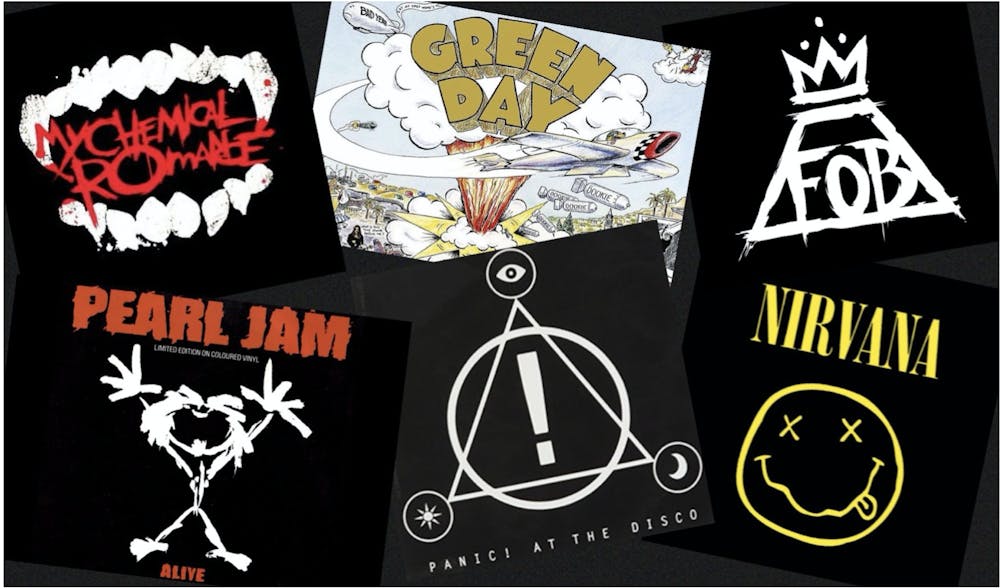All genres of music can be connected to one another as far as history and influences go, but some have a stronger influence than others. There are certain genres and bands that have direct, yet niche impacts on how musical evolutions make way for new artists to take those changes in stride. Grunge music and the music of the modern day emo-phase are a prime example.
Grunge music is a subgenre of alternative rock that became prevalent in the mid-1980s and stuck around through the 1990s. This musical category includes bands such as Pearl Jam, Green Day, Nirvana, Soundgarden, Alice in Chains, Stone Temple Pilots and Smashing Pumpkins. Originating from the American Pacific Northwest, grunge music is a combination of punk rock and heavy metal. Additionally, the lyrics of the genre are known for being angsty, covering topics like isolation, abuse, social alienation, trauma and more. The word “grunge” itself means “one that is grungy” or “shabby or dirty in character or condition,” something not too far off from negative descriptions of the biggest listeners of grunge music: Generation X.
Generation X generally includes anyone born from 1965 to 1980 and is called Gen X for short. Gen X is also called the “latchkey generation,” which stems from changing functions of society at the time such as women joining the workforce at increasing rates and divorces becoming more common. As a result, post-school child care from maternal figures turned into kids having to let themselves into their houses by using keys to unlock the latches to their front doors, hence the nickname. Being a child of divorce and/or being forced to learn to function independently from any parental figure at a young age had a lot of emotional repercussions that are mirrored in the subject matter of grunge music. Gen Xs’ frustration with the way they were often portrayed as quitters, pessimistic and discontented was mirrored in grunge music as well.
The word “emo” originated from “emocore”, a genre of hardcore punk that centers around being emotional, but has evolved to describe the modern day emo phase. Emo phases are a core part of growing up for a lot of people, typically occurring between the ages of 13 and 18 years old. Generally happening during one’s period of adolescence-driven self discovery, they are an important part of the developmental stage of one’s identity and taste in music.
For the young adults and teenagers of Generation Z– myself included– there is very specific music that my age group remembers as being the center of our emo phases. The artists everyone listened to may have varied based on one’s friend group, hometown culture, family, school environment, etc., but there was a widespread, unspoken agreement of the need for the genre. While your music of choice didn't always fall into the genre of emocore specifically, it did fall into the same genre grunge music evolved from at a different point in time: alternative rock.
In the 2010’s, Gen Z bowed down to alternative bands because of how they fueled our angst and made us feel seen during our emo phases. This includes but is not limited to: Panic! at the Disco, Fall Out Boy, My Chemical Romance, Twenty One Pilots, Paramore, All Time Low, Arctic Monkeys, The 1975, The Neighbourhood, Imagine Dragons, The Black Keys and The Killers. Late 90s post-grunge alternative rock bands that would have been influenced by the grunge era — such as The Strokes, Foo Fighters, Linkin Park, Blink-182, Three Days Grace, etc. — also made their way into our ears.
Because Generation Z is composed of the children of Generation X, it’s intriguing to look at how their angst was seemingly passed down, even if it was unintentional. My parents and myself fit into this categorization, and though I recall listening to grunge music as a result, I only recently began to comprehend why they have such a strong connection to it.
The feelings of anger and dysfunction that shaped grunge music and gave Generation X a feeling of being understood for having those same feelings is very similar to how Generation Z’s favorite emo-alternative rock music gave us something to hold onto as we figured out our teenage angst.
For both generations, there was (and still is) solace in knowing that someone you’ve never met became famous by writing music about going through the same things you are. Connecting to music in general is therapeutic, even if the context isn’t sad and angst-filled, but there’s something special about the way grunge music shaped emo-alternative rock and how they each shaped two separate generations.
Tate Raub is a sophomore studying strategic communication at Ohio University. Please note that the views and opinions of the columnists do not reflect those of The Post. Want to talk more about it? Let Tate know by tweeting her @tatertot1310.
Opinion Editor






